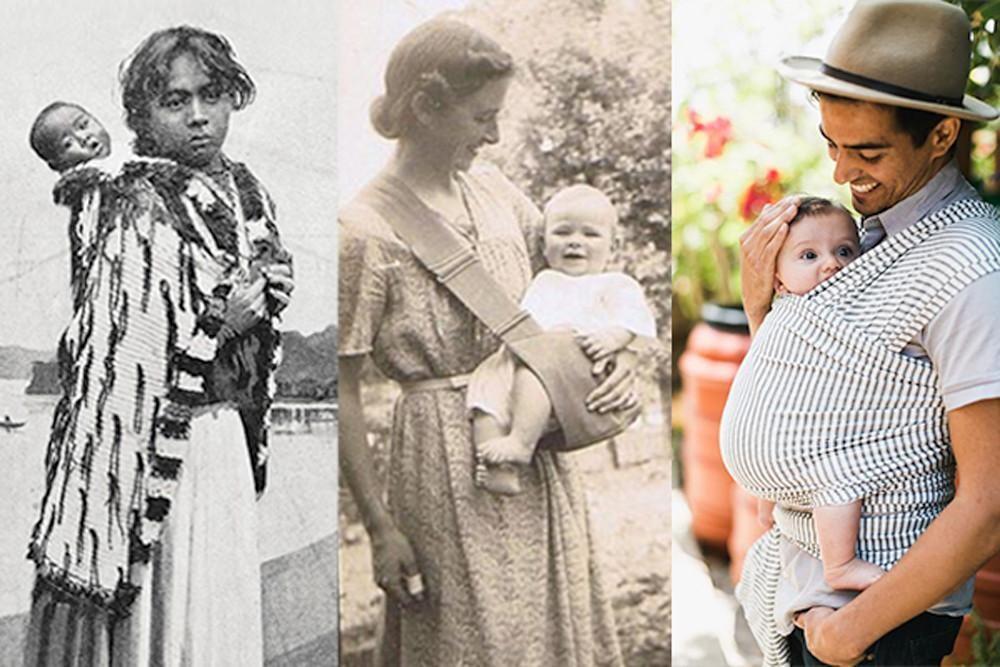BABY
Baby Carriers: Ancient Wisdom Makes a Comeback
Why everyone these days is wearing their baby!

Written by
Dr. Harvey Karp

SHARE THIS ARTICLE
PARENT PICKS
Bestsellers
BABY

Written by
Dr. Harvey Karp

SHARE THIS ARTICLE
Bestsellers
"I used to think that people with baby carriers were granola people and hippies…but now, I think women are weird if they don't use one.” Debra, mother of twins Audrey and Sophia
A final example of an old, discarded custom that has been resurrected, thanks to recent scientific studies, is the use of baby carriers and slings. These devices allow babies to be carried while leaving their mom’s hands free for other jobs. These simple folds of cloth are so valuable to new parents that I suspect they were one of the first items of clothing ever invented!
Despite their great practicality, however, infant carriers were discarded by our Western culture many generations ago. During the late 1800’s baby carriages replaced the old practise of carrying babies for walks. Pushing a “baby buggy” or a “pram,” as these carriages were referred to, was seen as being more refined and lady-like than strolling down the avenue with your baby draped over your shoulder.
This preference to not hold babies was reinforced by the vocal opinions of experts who warned parents to avoid carrying their babies “too much.” In 1894, Dr. Emmett Holt, the “Dr. Spock” of his day, cautioned parents not to pick up their crying babies, not to spoil them with too much carrying and never to rock them to sleep! So, for decades, parents continued to transport their infants exclusively in carriages and strollers.
Imagine, though, what it’s like being in a stroller…from your baby’s point of view. There she is, sunken in a bucket seat unable to see you or even hear you very well. And, when you stop walking, an eerie stillness descends around her! Strollers are certainly useful and valuable tools for long trips (and, heavy babies).
However, in the late 1980s, a new series of medical and anthropological reports began to push these rolling baby seats back into a more limited role. These studies by top scientists, like Ron Barr from McGill University, reacquainted our culture with the prehistoric practise of carrying babies in slings.
Babies adore slings and infant carriers of all variety. They nurture their senses in a rhythmic, calming way. Babies who are carried become enveloped by the constant presence of their parent’s warmth, scent, movement, touch and sounds. If I were asked to compare strollers to slings, I’d say that strollers are like singing “Row, row, row your boat” over and over again while slings are like a full chorus performing “The Hallelujah Chorus”!
In 1986, Dr. Barr and his associate Dr. Urs Hunziker asked women to carry their babies at least 3 hours a day (in a sling or their arms). They discovered the more a baby was carried the calmer and happier she became. Overall, these cuddled infants had 43% less crying. Thanks, in part to studies like this, infant carriers have been saved from the brink of extinction and sent back up to the “top of the charts”.
In the 1970s, women carrying their babies in slings may have been considered counter-cultural oddities, but these days, mothers from Tacoma to Tallahassee are snapping up infant carriers like hot cakes. Now, they’re so much a part of our culture it’s almost odd for a mom not to “wear her baby”!
Disclaimer: The information on our site is NOT medical advice for any specific person or condition. It is only meant as general information. If you have any medical questions and concerns about your child or yourself, please contact your health provider. Breastmilk is the best source of nutrition for babies. It is important that, in preparation for and during breastfeeding, mothers eat a healthy, balanced diet. Combined breast- and bottle-feeding in the first weeks of life may reduce the supply of a mother's breastmilk and reversing the decision not to breastfeed is difficult. If you do decide to use infant formula, you should follow instructions carefully.